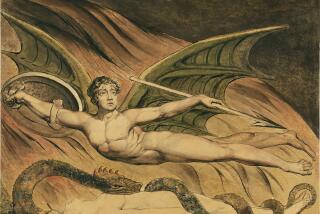Working Man’s Art : BIOGRAPHY : BLAKE: A Biography,<i> By Peter Ackroyd (Alfred A. Knopf: $35; 416 pp.)</i>
- Share via
The modern biographer is usually a faceless drudge grimly bound by a publisher’s commission to his or her subject like one of Dante’s damned. Exceptions are rare (George D. Painter on Marcel Proust, Richard Ellmann on James Joyce, Leon Edel on Henry James).
There have been a number of biographies of William Blake, notably Mona Wilson’s elegant and authoritative “Life” of 1927, but surely Peter Ackroyd is the natural chronicler of his days and doings. Ackroyd has already given us a monumental (for once the word is wholly apt) biography of Charles Dickens, another London visionary, while even the titles of his novels--”The Great Fire of London,” “Hawksmoor,” “Chatterton,” “Dan Leno and the Limehouse Golem”--are an indication of his obsessive fascination with the English capital, which under his fevered regard becomes suffused with a lurid, Blakean radiance.
William Blake was born in Soho in 1757: “He left the city only once, and most of his life was spent in the same small area bounded by the Strand, Holborn and Oxford Street.” The city for him was a miraculous place, and a place of miracles; as Ackroyd has it, “if Blake understood the energy and variety of London, he was continually aware of its symbolic existence through time: In his epic poetry, and the vast concourse of figures who flow through it, we find the pity and mystery of existence in a city he described as ‘a Human awful wonder of God!’ ”
As well as the city, the other great influence on Blake’s philosophy and religion was the dissenting tradition into which he was born. His father, James, was a hosier, and he and his wife, Catherine, nee Hermitage, were both stout adherents of a dissenting sect, the precise nature of which is not known. The times were aboil with religious and political energies, and Blake’s early years rang with the teachings of great visionaries such as Emanuel Swedenborg and Jacob Boehme.
However, Blake had little formal education, which was probably to the good, for otherwise the creativity of this quintessential autodidact might have been dulled. Like W.B. Yeats, one of his stoutest champions, he was compelled to construct his own, personal mythology: “I must Create a System, or be enslav’d by another Mans.”
He had seven siblings, one of whom, his beloved brother Robert, though he died at 19, was an important influence on Blake and a spectral companion to him throughout his life. At age 15, William was apprenticed to the engraver James Basire, and over the years of his training he began that process by which he would transform himself from a craftsman into a universal artist. Yet as Ackroyd is at pains to show, at a certain essential level Blake never ceased to be a craft worker. “Blake was in no sense a ‘Romantic’ artist, like those of the next generation, who despised trade and who tended to withdraw from the urban turmoil of finance and competition; he was a lower-middle-class tradesman, a mystic intimately involved in the world of commerce and craft.”
Ackroyd limns a wonderful portrait of Blake at work in Basire’s studio; it is worth quoting in full, for it gives the flavor not only of an 18th century workshop but also of Ackroyd’s method and clotted, Dickensian style, so apt for his subject:
”. . . He soon became accustomed to the smell of nut oil, varnish and lamp black from Germany as well as to the ink smeared across his hands and his face. For the next seven years--indeed for the rest of his life--he was surrounded by iron pots for the boiling of the oil, pans forwarming the copper plates, tallow candles, racks of needles and gravers, fine linen cloths to strain in the plates, old rags for wiping the ink off the plates, pumice stones to polish the plates, feathers for smoothing the ground of varnish on the plates. Stacked around him were the sheets of fine paper, as well as the plates themselves, which were the thickness of a half-crown; there was the small leather cushion filled with sand, upon which he rested the plate while engraving, and the square wooden press with its tables, rollers and woolen cloths. It was a dirty and malodorous workplace but it was one against which he never felt the slightest revulsion.”
Out of apprenticeship, Blake went into business in a small way, hiring a shop to sell his own prints and offering himself as an illustrator of books. He had little success, and in worldly terms his life was to be a failure. Despite unflagging fortitude, he felt this failure keenly, and in later years grew embittered and resentful of the success of lesser artists of his acquaintance. He was sustained by the companionship of his wife, the extraordinary Catherine, who never faltered in her belief in him and his genius, not to mention his visions.
Ackroyd repeats, from one of Blake’s Victorian biographers, this charming glimpse of her: “When he explained to visitors the nature of his second sight, she would look at her husband with an awe struck countenance, and then at his listener to confirm the fact.” Although Catherine Blake has left scant evidence of herself, Ackroyd is rightly generous in his acknowledgment of her importance: “It is a story of the utmost devotion, virtually without parallel in the history of English letters, and it can fairly be said that without Catherine Blake none of the great works of her husband would have appeared.”
Ackroyd devotes much of his space and energies to a detailed consideration of Blake as an artist of profound originality and significance. He emphasizes that Blake’s art--that is, his poetry and his painting--was all of a piece. His books, which he engraved and published himself, are a unique melding of word and image which must be considered in their wholeness and uniqueness as objects if they are to be properly understood. If Ackroyd is right, and I think he is, it is somewhat dispiriting, for how many of us will ever have the chance to hold and examine these precious artifacts?
Blake’s visionary system is intricate, outlandish, hermetic and, I would contend, at times preposterous. He held fast to certain essential precepts, among them that “everything that lives is holy!”; that sexual energy is one of the prime moving forces in the world and that its repression leads to conflict and spiritual death. In religion he believed, as Wallace Stevens declares in one of his poems, that “God and the imagination are one.” Perhaps the most concise statement of his beliefs is this passage, not quoted by Ackroyd, from “The Marriage of Heaven and Hell”:
The ancient Poets animated all sensible objects with Gods or Geniuses, calling them by the names and adorning them with the properties of woods, rivers, mountains, lakes, cities, nations, and whatever their enlarged & numerous sense could perceive.
And particularly they studied the genius of each city and country, placing it under its mental deity;
Till a system was formed, which some took advantage of, and enslav’d the vulgar by attempting to realize or abstract the mental deities from their objects: thus began Priesthood;
Choosing forms of worship from poetic tales.
And at length they pronounc’d that the Gods had order’s such things.
Thus men forgot that All deities reside in the human breast.”
It might be the might voice of Zarathustra himself.
Blake died in 1827, at the biblical age of threescore and ten. His friend George Richmond wrote: “He died on Sunday night at 6 o’clock in a most glorious manner. He said He was going to the Country he had all His life wished to see and expressed Himself Happy, hoping for Salvation through Jesus Christ--Just before he died His Countenance became fair. His eyes Brighten’d and He burst out into Singing of the things he saw in Heaven.”
Already the new world of the Romantics was occluding the radiant sphere that he had spun. His work never faded from the public view, however, though it took time before the true nature of his genius was recognized. Like all true artists, he never lost belief in himself, or if he did, he soon regained it. As he wrote, with that inimitable mixture of the transcendental and the homely so characteristic of him as artist and human being: “If a man is master of his profession, he cannot be ignorant that he is so; and if he is not employed by those who pretend to encourage art, he will employ himself, and laugh in secret at the pretense of the ignorant, while he has every night dropped into his shoe, as soon as he puts it off, and puts out the candle, and gets into bed, a reward for the labors of the days, such as the world cannot give, and patience and time await to give him all that the world give.”
More to Read
Sign up for our Book Club newsletter
Get the latest news, events and more from the Los Angeles Times Book Club, and help us get L.A. reading and talking.
You may occasionally receive promotional content from the Los Angeles Times.








